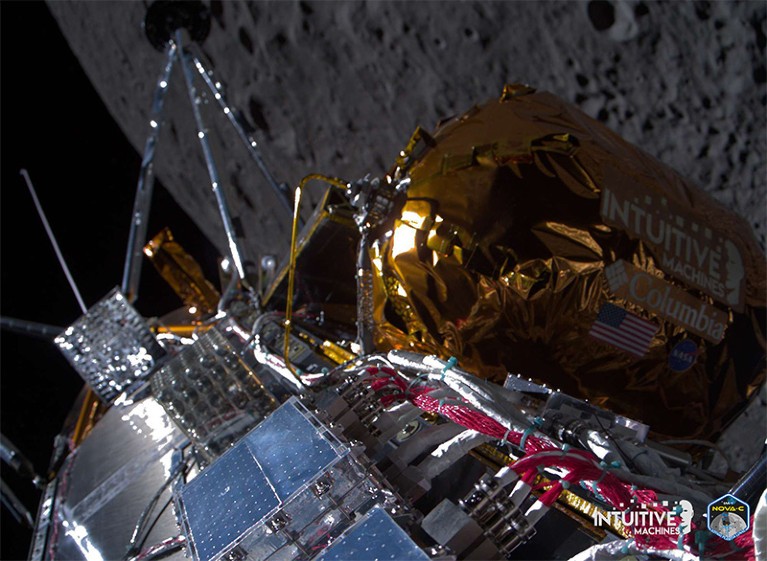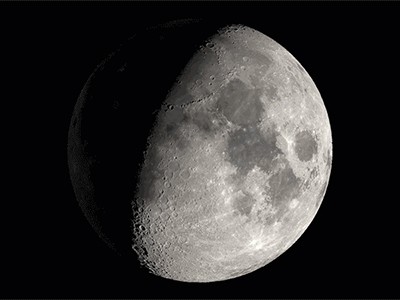
[ad_1]

The spacecraft Odysseus passes over the Moon on 21 February on its way a successful landing on 22 February.Credit: Intuitive Machines/NASA CLPS
In a historic lunar accomplishment, the first private spacecraft to land successfully on the Moon touched down on 22 February. The spacecraft, named Odysseus and built by Intuitive Machines in Houston, Texas, also became the first US lunar lander since 1972, when the last crew of Apollo astronauts visited the Moon.
Odysseus offered up some nail-biting moments in the hours before landing, such as the malfunction of the laser rangefinders that were supposed to help guide its autonomous journey down to the lunar surface. Mission engineers had to upload a software patch to jury-rig it to use a secondary laser provided by NASA instead.
The exact state of the spacecraft remained unclear immediately after its landing, which occurred at 5:23 p.m. Houston time. But it was sending a faint signal back to mission control in Houston, indicating that at least some portion of it had survived the touchdown. “Odysseus has found its new home,” said mission director Tim Crain as the control room burst into cheers.
Lunar return
Regardless of how operational the spacecraft might be going forward, the landing is a major shot in the arm for US and commercial efforts to return to the Moon. NASA paid for much of the private mission and is counting on companies such as Intuitive Machines to help ferry equipment and scientific instruments to the Moon in preparation for returning astronauts there.
Private companies are flocking to the Moon — what does that mean for science?
“The US has returned to the Moon,” said NASA administrator Bill Nelson. “Today is a day that shows the power and promise of NASA’s commercial partnerships.”
The first images from the lunar surface are expected within a few hours of the landing, depending on how communications with the spacecraft go. If Odysseus’s scientific payloads check out successfully, they could collect data for up to seven days, until night falls at the landing site and there is no more solar power left for operations.
Five of the last nine Moon landing attempts have failed. Among the failures is a mission launched last month by Astrobotic in Pittsburgh, Pennsylvania, which ran out of fuel within hours of launch due to a valve malfunction. But also last month, the Japanese space agency succeeded in putting its SLIM lander near Shioli crater near the Moon’s equator, although the spacecraft landed upside down.
Speedy traveller
Odysseus launched on 15 February from Cape Canaveral in Florida, and headed directly for the Moon. Along the way, it fired its engine several times to set itself on the correct trajectory and transmitted images of the Earth and the Moon. It entered lunar orbit on 21 February, initially circling 92 kilometres above the surface before making its landing attempt.
Japan’s successful Moon landing was the most precise ever
The spacecraft fired its engines to descend to a lower altitude, then moved into an autonomous series of maneouvres in which it re-oriented itself and began assessing the craters and boulders beneath. It navigated towards its intended landing site and fired its engines again to slow its descent, ultimately touching down on the surface.
The six-legged, phone-booth-sized spacecraft landed near the Malapert A crater, around 300 kilometres from the lunar south pole. NASA is interested in the Moon’s south pole because the region’s dirt and shadowy craters might contain ice that could provide fuel and other resources for future lunar explorers. Most lunar landers have visited the Moon’s equatorial regions; the only mission that has landed near the south pole is India’s Chandrayaan-3, which touched down last August.
Bargain missions
Odysseus is the second launch, after Astrobotic’s attempt, in NASA’s Commercial Lunar Payload Services (CLPS) programme, which aims to incentivize small aerospace companies to fly payloads for NASA and others to the Moon at low cost. NASA paid Intuitive Machines $118 million to develop Odysseus, which is a fraction of the cost of a typical interplanetary mission.
NASA has six payloads on board Odysseus, including a set of cameras to study how rocket exhaust interacts with the lunar surface. The space agency wants to use CLPS flights to test technologies for its own return to the Moon, including plans to send astronauts to the lunar south pole as soon as 2026. A second Intuitive Machines Moon mission is slated to carry an ice drill to the south polar region, perhaps by the end of this year.
Odysseus is the first craft to burn a methane-based rocket fuel in space. Methane-based propellants are more efficient and environmentally friendlier than conventional rocket propellants such as those including kerosene. But they can also be more difficult to work with because they need to remain at ultra-cold temperatures. Several other aerospace companies are planning to use methane fuels in the future.
Source link






